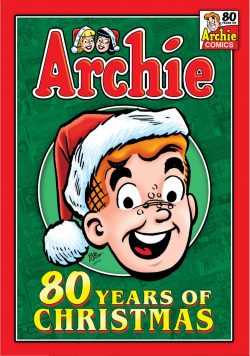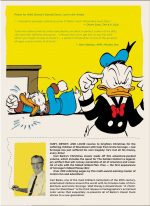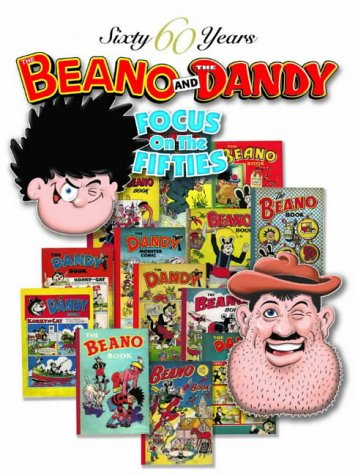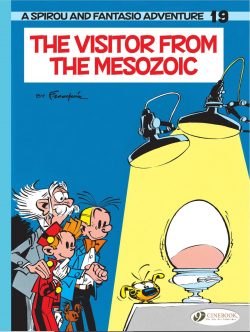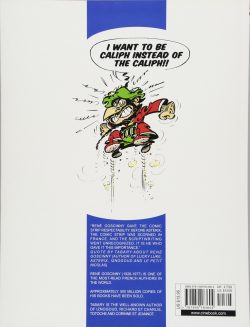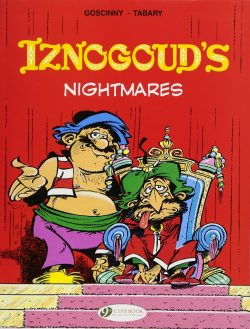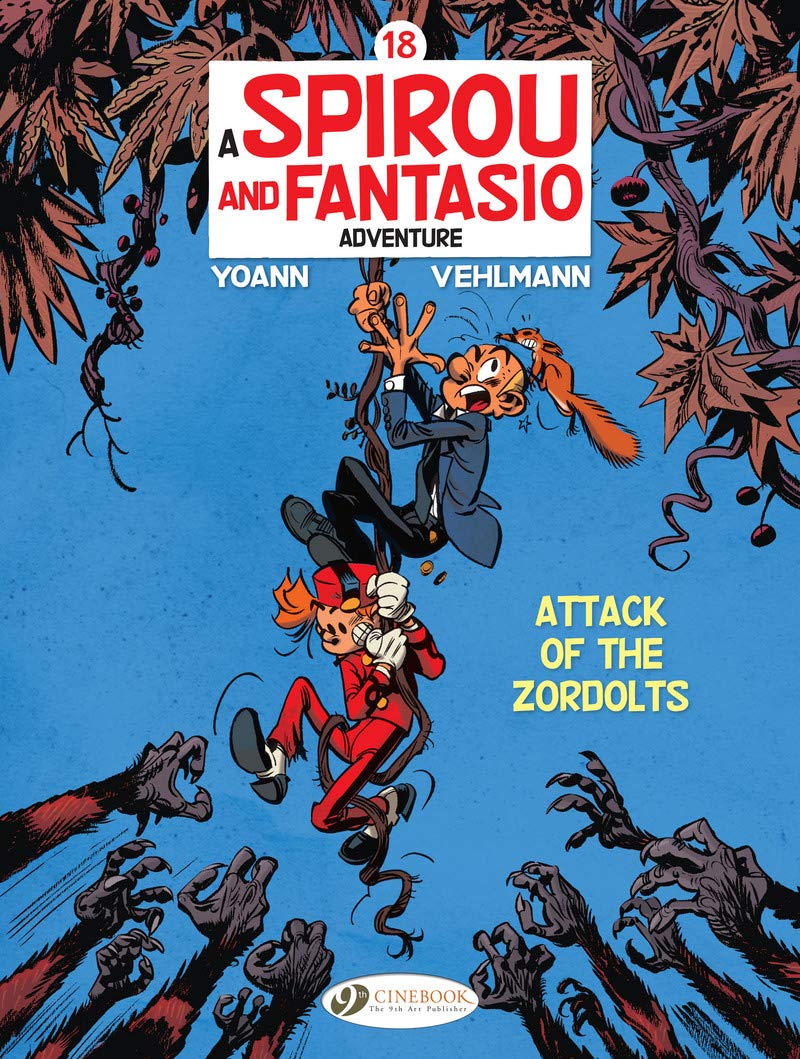
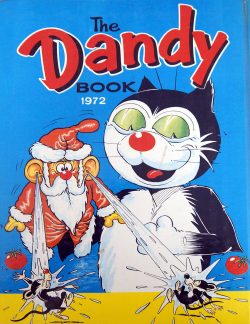
By many & various (D.C. Thomson & Co.)
ISBN: 978-0-85116-043-6 (HB)
For generations of British fans Christmas means The Beano Book, The Broons, Oor Wullie and making every December 25th magical. There used to be many more DC Thomson titles, but the years have gradually winnowed them away. Thankfully, time means nothing here, so this year I’m concentrating on another Thomson Christmas cracker that made me the man wot I am. As usual my knowledge of the creators involved is woefully inadequate but I’m going to hazard a few guesses anyway, in the hope that someone with better knowledge will correct me whenever I err.
The Dandy comic predated The Beano by eight months, utterly revolutionising the way children’s publications looked and – most importantly – how they were read. Over decades it produced a bevy of household names that delighted millions, with end of year celebrations being bumper bonanzas of the weekly stars in magnificent bumper hardback annuals.
Premiering on December 4th December 1937, The Dandy broke the mould of its hidebound British predecessors by utilising word balloons and captions rather than narrative blocks of text under sequential picture frames. A colossal success, it was followed on July 30th 1938 by The Beano. Together they revolutionised children’s publications. Dandy was the third longest running comic in the world (behind Italy’s Il Giornalino – launched in 1924 – and America’s Detective Comics in March 1937).
Over decades the “terrible twins” spawned countless cartoon stars of unforgettable and beloved household names who delighted generations of avid and devoted readers…
The Christmas Annuals were traditionally produced in the wonderful “half-colour” British publishers used to keep costs down whilst bringing a little spark into our drab and gloomy young lives. The process involved printing sections with only two (of potentially 4) plates, such as blue/Cyan and red/Magenta as seen in this majority of this tome. The versatility and palette range provided was astounding. Even now the technique screams “Holidays” to me and my contemporaries, and this volume uses the technique to stunning effect.
As you can see, the fun-filled action begins on the covers and continues on the reverse, with front-&-back covers and Introduction pages occupied by superstar Korky the Cat (by Charlie Grigg) setting the tone with a sequence of splendid seasonal sight gags.
D.C. Thomson were also extremely adept at combining anarchic, clownish comedy with solid fantasy/adventure tales. The eclectic menu truly opens with some topical environmentalism working as drama in Paddy Brennan’s ‘Guardian of the Red Raider’. Such picture thrillers still came in the traditional captioned format, with blocks of typeset text rather than word balloons. Here, bedridden schoolboy Freddy Gibbon “adopts” a vixen and her cubs, secretly safeguarding them from harm until they can fend for themselves.
From there we revert to the cheeky comfort of simpler times as Dirty Dick – by the incredibly engaging Eric Roberts (no, not the actor) – finds our perennially besmudged and befouled boy on his best and cleanest behaviour in anticipation of a visit from his American penfriend. However, in comics good intentions count for nothing…
Appropriately switching to black and blue plates, we next meet eternal enemies Bully Beef and Chips. Drawn by Jimmy Hughes, the thuggish big kid’s antics invariably proved that a weedy underdog’s brain always trumped brutal brawn, as here where little Chips orchestrates well-deserved payback after Bully forces little lads to play with his dangerously-rigged Christmas crackers…
Hugh Morren’s The Smasher was a lad cut from the same mould as Dennis the Menace and in the first of his contributions carves a characteristic swathe of anarchic destruction, when seeking to join a cowboy movie location shoot,
A quick switch to red & black – and all the tones between – signals the advance of hard-pressed squaddie Corporal Clott (by David Sutherland) who again bears the brunt of cruel misfortune and surly Colonel Grumbly when ordered to provide a slap-up feed for a visiting General…
The prolific Roberts always played a huge part in making these annuals work and next up his signature star Winker Watson hosts double-page picture puzzle ‘Catch the Imps!’: testing mind, eye and vocabulary before Shamus O’Doherty’s Bodger the Bookworm is seduced away from his comfortable reading to play football… with catastrophic repercussions…
Back in black & blue, traditional chaotic school hijinks get a cruel and crazy feudal spin in Ron Spencer’s Whacko! before we stay on topic but jump 500 years to the then-present and a different take on the education crisis. Whilst much comics material was based on school as seen by pupils, George Martin’s Greedy Pigg featured a voracious teacher always attempting to confiscate and scoff his pupils’ snacks. This time, he forsakes tuck boxes and extends his reach to the fodder fed to zoo animals – and gets what he deserves after masquerading as a gorilla…
Unforgivably racist but somehow painfully topical, Hughes’ Wun Tun and Too Tun the Chinese Spies traces the misadventures of badly-briefed oriental agents in old Blighty. Here they get lost in and misunderstand the point of sewers, after which Sutherland’s Desperate Dan offers a range of incidents deriving from the sagebrush superman letting his beard grow out of control.
The daftness drifts into more brilliantly entertaining eco-messaging as Peter Potter’s Otters – by Grigg employing his dramatic style – sees a gamekeeper’s son contrive to rescue a family of river-dwelling “pests” from the community seeking to eradicate them…
Jack Edward Oliver’s My Woozy Dog Snoozy proves utterly useless as a security guard, but does usher in green & black tones to welcome back Korky the Cat, whose clash with a fish farm’s “security guards” segues into a doggerel dotted Zany Zoo feature. An examination of The Smasher’s evolutionary forebears heralds a resumption of blue hues as Roberts delivers another classic Winker Watson yarn that is now sadly drenched in controversy and potential offense.
It begins when the Third Form lads of Greytowers School act on their love of the BBC’s Black and White Minstrel Show (look it up, but be prepared to be appalled before realising just how far we’ve come…): adding a blackface minstrel skit to the Christmas Concert. When chastised and rebuffed by form master Mr. Creep, schoolboy grifter Winker institutes a cunning scheme – worthy of Mission Impossible or Leverage – to make the teacher the butt of a joke and star of the show…
The green scene enjoys one last outing for a lengthy police spoof. Created by John Geering and played strictly for laughs, P.C. Big Ears was an overzealous beat copper with outrageous lugholes whose super-hearing and faithful dog Sniffer helped him crush “crime”. Here the dynamic duo are hot on the trail of a truant schoolboy, but pay a irritating price for their dutiful diligence, after which another light-hearted drama ensues, courtesy of Bill Holroyd.
With premium blue & red plates back in play home-made mechanoid Brassneck kicks off an avalanche of trouble after a service by his inventor. Uncle Sam pal warns the robot-boy’s pal Charley Brand that the automaton might be a little fragile for a while but is blithely unaware how rowdy and boisterous school can be. When a couple of unavoidable buffets trigger wild outbursts, Brassneck’s antics close the school, empty the parks and even cause animal escapes from the zoo before order is finally restored…
Desperate Dan then catches cold and almost decimates the environment in his efforts to get warm and stop sneezing before Korky the Cat suffers the downside of camping, and pint-sized hellion Dinah Mite (drawn by Ron Spencer) tests some possible careers should she ever leave school.
Another blue section opens with animal gags in Jokey Jumbo and Winker Watson puzzle feature ‘It’s as Easy as ABC’ before My Woozy Dog Snoozy compounds his worthlessness when a burglar breaks in.
A switch to red and black sees Corporal Clott suckered by a spiv and become the proud new owner of a lethally destructive vacuum cleaner after he replaces the naff motor with a leftover jet engine. Blue tones are back as George Matin’s big-footed klutz Claude Hopper learns why he’s not cut out for a job waiting tables and Korky the Cat wins a fancy dress competition by being extremely cool…
More red & blue pages picture Dirty Dick at his dustily destructive worst before a switch to yellow & black plates finds Greedy Pigg imitating a tramp to get scrumptious handouts before Wun Tun and Too Tun the Chinese Spies return in another distressingly outdated and inappropriate espionage episode.
Rendered in red and black. Sandy Calder powerfully illustrates Scruffy the Bad-Luck Doggie as ordinary kid Danny Dunlop saves a scrappy mutt from bullies trying to drown it, but takes some time and effort – and a few hard knocks – adjusting to being the owner of a semi-feral delinquent dog…
Sentiment surrenders to surreal silliness and yellow hues as Desperate Dan teaches a dog how to be fierce, before Bodger the Bookworm enflames his family by practising matchstick tricks and Korky successfully poaches a fish in more ways than one, after which black & blue tones detail a pretty Darwinian battle for survival and supremacy amongst alley cats as Boss of the Backyards (by Murray Ball – whose wonderful Footrot Flats strips are just crying out for a modern archival edition) sees a tough newcomer challenge a wild moggy in the kingdom of bins and backstreets…
Dirty Dick is tarred by own insolence – and tar – in a very early example of photobombing and My Woozy Dog Snoozy turns the tables on his longsuffering owner, before P.C. Big Ears finds his own hound complicit in apple scrumping. Corporal Clott then dumps the colonel in a frozen river and Korky again profits from his thieving ways…
Another flush of red & blue captures Bully Beef and Chips causing chaos with a doctor’s play set and Greedy Pigg outsmarted by the dog he borrowed to steal food for him, and true blue drama Bold Ben’s Boulder (by Victor Peon?) has a young boy save his uncle’s fortune and life when Burmese bandits go on a kidnapping spree before one final flush of red & black sees Desperate Dan solve a lighting crisis with a little illuminating larceny…
With Puzzle Answers and the aforementioned Korky endpapers wrapping up proceedings, let’s celebrate another tremendously fun book; with so much merriment on offer I can’t believe this book is 51 years old, and still available through second hand outlets.
The only thing better would by curated archive reissues and digital editions…
© D.C. Thomson & Co., Ltd, 1971.


